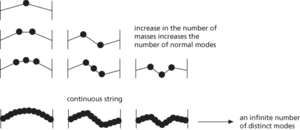A convenient set of simple vibrational motions of an oscillatory system. The normal modes of an oscillating system are labelled by their characteristic frequencies. Modes of the same frequency are said to be degenerate in that frequency. More generally, when vibrational wave energy propagates through any physical system, the waves interact with the medium through which they are travelling. Any periodic response of the system may be deconstructed as a Fourier series of normal modes by the superposition principle. Oscillating systems possesses as many normal modes as they have degrees of freedom. For example, masses connected by electric strings and set to vibrate may be analysed in terms of their normal modes. The diagram below shows systems containing 1, 2, 3, 4 and an infinite number (a continuous string) of masses. If these simple oscillations are confined to the vertical plane, the numbers of degrees of freedom for each of the five cases are equal to the numbers of masses present. The second diagram shows an application of the powerful superposition principle to the deconstruction of a square wave response by continuous sine waves. As with the normal modes of the continuous string, sine waves constitute an infinite set of normal modes, the addition of more and more members of this infinite set leads to better and better approximations of the periodic square wave (see also spherical harmonics).

Normal modes.
- Persia
- Persian wars
- persimmon
- persistence
- persistent
- persistent cookie
- persistent data
- persistent organic pollutant
- persistent programming
- persistent state
- persistor
- person
- personal area network
- personal assistant
- personal blog
- personal communications device
- personal computer
- Personal Computer Memory Card International Association
- personal construct theory
- personal data
- personal digital assistant
- personal disposable income
- personal egress air pack
- personal equation
- personal equity plan